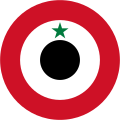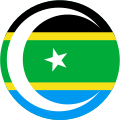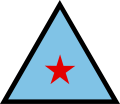Yemeni Air Force
| Yemen Air Force and Air Defence | |
|---|---|
| القوات الجوية اليمنية والدفاع الجوي Al-Quwwat al-Jawwiya al-Yamaniya wal-Difa' al-Jawwiy | |
Yemeni Armed Forces | |
| Engagements |
|
| Commanders | |
| Chief of Staff of the Yemeni Air Force | Yak-40 |
Yemeni Armed Forces |
|---|
 |
| Leadership |
| Military services |
|
The Yemeni Air Force (
History
Early Yemeni military flying
After being confronted by British air power during several conflicts in the 1920s,
This changed in the late 1940s, when several aircraft were bought from different sources: a single
Birth of the North and South Yemeni Air Forces
The Yemen Arab Republic Air Force (YARAF) was officially established on 20 November 1967. On this month, the Soviets delivered nine
Meanwhile, in what would then become South Yemen, the British had started to form an embryonic air force. Called the South Arabian Air Force (as an air corps of the
Build-up and wars between the two Yemens
The PDRYAF participated in the short
Shortly after the end of the conflict, the PDRYAF started receiving its first MiG-21MFs. By 1974, more than 40 of them had been delivered. Training on the new aircraft was supported by a group of Cuban advisors.[13] Around 1976, a dozen of Sukhoi Su-22s was delivered to replace the Il-28 bombers.[14] In the frame of South Yemeni involvement in the Ogaden War, the PDRYAF sent 12 MiG-17Fs and two MiG-15UTIs to Ethiopia in 1977, together with pilots and ground personnel. Another contingent followed in early January 1978, including some MiG-21 pilots; one of them was killed when his aircraft, a MiG-21MF donated to Ethiopia by the USSR, was shot down by Somalian air defences on 15 February.[15] The MiG-15s and MiG-17s were never returned to South Yemen, and most of their pilots converted to Su-22s.[14]
In February 1979,
Following the
Meanwhile, the PDRYAF was getting some reinforcements as well: six additional MiG-21s were delivered shortly after the 1979 war, while 40 Su-22Ms, Su-22M3s and Su-22UM3Ks were delivered by 1986.
Unification and civil war
On 22 May 1990, North and South Yemen were officially
Even though the PDRYAF had been considerably weakened by the 1986 civil war, its commanders still assessed it as superior to its northern counterpart, and expected it to establish air dominance. On the morning of 4 May, around 40 MiG-21s and Su-22s were sent to attack several targets in the north, including the Presidential Palace in Sanaa and several YARAF air bases.[25] While these attacks caused significant damage and the YARAF did not react to it, the results still fell short of expectations. However, the PDRYAF kept on trying, and its Su-22 units performed several additional long-range bombing missions through the war, achieving notable results. Meanwhile, the YARAF was also using its own Su-22s, as well as MiG-21s, against targets in the south. YARAF F-5Es were also used in air combat and scored several victories. They allowed the Northerners to achieve local air dominance over crucial parts of the front lines. Since both air forces operated similar types of aircraft, friendly fire incidents were very common.[26]
As the war continued, the Northerners' territorial gains and the losses took their toll on the PDRYAF. Even though its pilots often flew three or four sorties per day, the general situation of the Southerners was worsening. It was in this context that the PDRYAF introduced to service Mikoyan MiG-29 fighter-bombers. Bought second-hand from Moldova, these aircraft were flown by Eastern European mercenaries, and saw their first combat use on 29 June. Despite being the most modern combat aircraft available in Yemen, the MiG-29s did not provide the PDRYAF with an advantage in air combat, because their pilots were inadequately trained in air-to-air combat. Indeed, the only reported air-to-air action involving a MiG-29 was an encounter between one MiG and two F-5Es on 29 June. Neither side opened fire, and all three aircraft came away safely. The next day, South Yemeni president Ali Salem al Beidh fled abroad, followed by thousands of South Yemenis. Dozens of PDRYAF members fled to Djibouti, Oman, and even the United Arab Emirates with their aircraft, while others fought to the bitter end. The war ceased on 7 July.[27]
Unified Yemeni Air Force
While the unified air force took on the remaining aircraft of the former PDRYAF, including around a dozen each of MiG-21s and Su-22s, several MiG-29s, and some Mi-8s, Mi-17s and Mi-14s, it almost only consisted of the former YARAF. Its combat aircraft were concentrated on air bases in the north of the country, and it retained the YARAF's structure. In 1995-1996, two additional MiG-29s were bought from Kazakhstan. In 1996, the remaining Su-22s and Su-22Ms were withdrawn, and four Su-17M4s were bought from Ukraine. Most aircraft of the more modern Su-22 variants were then overhauled, a process which lasted well into the 2000s. In 1999, 12
Even though the appearance of MiG-29s in Yemen in 1994 did not have much of an impact on the air war, the type left an impression on Ali Abdullah Saleh's government. Correspondingly, in March 2000 negotiations were opened with Russia for the purchase of 24 aircraft. A year later, a contract for the delivery of 14 single-seaters and one MiG-29UB was signed. These aircraft, as well as those obtained from other countries, were to be upgraded to the MiG-29SM standard. Deliveries started in 2002, and continued until 2007. At that time, the Yemeni MiG-29 fleet reached its maximum strength, with a total of around 36 aircraft. These aircraft were the most advanced in the Yemeni combat fleet, as they were armed with R-77 air-to-air missiles, and Kh-29T and Kh-31P air-to-surface missiles.[29]
War in Sadah
The Yemeni Air Force was used extensively against the
War on Terror
As part of the
2011 Yemeni uprising
The Yemeni Air Force performed air strikes against opposition forces to the Saleh government during the
On 30 October, the al-Dailami air base, which shares the structures with
Saudi-led intervention in Yemen (2015–present)
On 19 March 2015, a first air raid against the internationally recognized Yemeni president
On 25 March 2015, two Yemeni Air Force aircraft, probably
During the initial days of the
The Yemeni Air Force did not completely join the Houthi rebels, as most of the personnel refused to take orders from their former enemy. Also the maintenance of the air-frames was mostly halted since the ousting of the Saleh regime in 2012[36][37] and thus, at the beginning of 2015, the situation of the Air Force seemed chaotic with most of the personnel deserted and air-frames lacking maintenance, effectively preventing the Yemeni Air Force to enter in the fight, remaining grounded during the Saudi-led intervention.[38]
The following few days, the coalition strikes started targeting the structures and air-frames to a more severe extent.
On 15 April 2015, a Saudi debriefing showed the Arab coalition strikers destroying two Su-22 and one F-5 jet fighters while they were sitting on the tarmac. The F-5 looked covered by a net, while the Su-22s were parked in the open.[39][40] Another picture showing the wrecks of two Su-22 and one F-5 jets emerged on 30 April 2015.[41] On 4 May 2015, evidence of a Yemeni Il-76TD at Sana'a International Airport engulfed in flames emerged.[42]
The fate of 10 Yemeni MiG-29 fighters remained unknown while the assessment on the number of other air-frames destroyed is difficult to establish. As of 2017 the Yemeni Air force after years of warfare and the Saudi-led coalition bombing is inoperable and non-functional. After government troops recaptured the Al Anad Air Base, the Yemeni air force was rebuilt and was trained by the UAE. They provide close air support.
Aircraft
| Aircraft | Origin | Type | Variant | In service | Notes | |
|---|---|---|---|---|---|---|
| Combat Aircraft | ||||||
MiG-21
|
Soviet Union | fighter | 19[45] | |||
| MiG-29 | Russia | multirole | 23[45] | |||
Sukhoi Su-22
|
Soviet Union | fighter / bomber | 23[45] | |||
| Northrop F-5 | United States | fighter | F-5E/F | 11[45] | ||
| Reconnaissance | ||||||
| Cessna 208 | United States | surveillance | 2[45] | |||
| Transport | ||||||
| Antonov An-26 | USSR/Ukraine
|
transport | 8[45] | |||
Helicopters
| ||||||
| Bell 206 | United States | trainer | 1[45] | |||
| Bell 212 | United States | utility / transport | 4[45] | |||
Bell UH-1
|
United States | utility | UH-1H | 4[45] | ||
| Mil Mi-17 | Russia | utility | Mi-17/171 | 34[45] | ||
| Mil Mi-14 | Russia | ASW / SAR | 2[45] | |||
| Mil Mi-24 | Russia | attack | Mi-24/35
|
14[45] | ||
| Kamov Ka-27 | Russia | utility | Ka-32 | 2[45] | ||
Trainer Aircraft
| ||||||
| Aero L-39 | Czech Republic | jet trainer | 28[45] | |||
| Northrop F-5 | United States | conversion trainer | F-5F | 2[45] | ||
Air Defense
The Air Defense, once separated from the Air Force, according to the standard Soviet segregation of armed forces, was merged into the Air Force.[46] Up to more than six hundred
There are about 8 Air defense brigades in the Yemeni air force. 6 of these sided with the Houthis and during the start of the Yemeni civil war, the Saudi-led coalition destroyed much of the systems and bases of 4 of these brigades, but two brigades survived the Saudi-led airstrikes as pro-Houthi army units scattered and hid most of the systems operated by these units. The remaining air defenses succeeded in shooting down two coalition F-16Cs, two Apaches and about a dozen UAVs. A new system built by pro-Houthi air defense personnel, which are originally
Roundels
-
Mutawakkilite Kingdom of YemenAir Force roundel (until 1962)
-
Yemen Arab Republic Air Force roundel (1962–1990)
-
South Arabian Air Force Roundel (1966-1967)
-
People's Republic of South Yemen Air Force roundel (1967-1980)
-
People's Democratic Republic of Yemen Air Force roundel (1980-1990)
See also
- Military of Yemen
References
Notes
- ^ Cooper 2017, p. 6
- ^ Cooper 2017, pp. 6–7
- ^ Cooper 2017, p. 8
- ^ Cooper 2017, pp. 8–9
- ^ Cooper 2017, p. 9
- ^ Cooper 2017, pp. 26–27
- ^ Cooper 2017, pp. 27–28
- ^ Cooper 2017, pp. 30, 32
- ^ a b Cooper 2017, p. 35
- ^ Cooper 2017, p. 34
- ^ Cooper 2017, pp. 36–37, III–IV
- ^ Cooper 2017, p. 37
- ^ a b Cooper 2017, p. 38
- ^ a b Cooper 2017, pp. 38–39
- ^ Cooper 2017, p. 39
- ^ Cooper 2017, pp. 39–40
- ^ Cooper 2017, p. 40
- ^ Cooper 2017, pp. 41–42
- ^ Cooper 2017, pp. 40–41
- ^ Cooper 2017, p. VII
- ^ Cooper 2017, p. 43
- ^ Cooper 2017, p. 44
- ^ Cooper 2017, pp. 45, 50
- ^ Cooper 2017, p. 45
- ^ Cooper 2017, p. 46
- ^ Cooper 2017, pp. 47–52
- ^ Cooper 2017, pp. 49, 51–54
- ^ Cooper 2018, pp. 13–14
- ^ Cooper 2018, p. 14
- ^ "BBC NEWS - Middle East - Yemen rebels 'down fighter jet'". 9 November 2009. Archived from the original on 19 August 2014. Retrieved 24 January 2015.
- ^ "Yemen: Iran's Role in an Intensifying Insurgency". Archived from the original on 7 June 2020. Retrieved 13 May 2015.
- ^ "BBC News - Yemen 'bombs house of suspected al-Qaeda militant'". 20 January 2010. Archived from the original on 5 February 2015. Retrieved 24 January 2015.
- ^ "Press Room". Archived from the original on 18 April 2012. Retrieved 24 January 2015.
- ^ "Rebel attack destroys Yemeni MiG-29s, closes Sanaa airport | World Tribune". Archived from the original on 19 November 2011. Retrieved 19 November 2011.
- ^ "Yemen's 'barely functional' air force points to US involvement in strikes". Archived from the original on 7 May 2015. Retrieved 1 April 2015.
- ^ "Yemen's Arab Spring Leaves its Air Force in Disarray". Archived from the original on 24 December 2017. Retrieved 9 May 2015.
- ^ "Yemen's 'barely functional' air force points to US involvement in strikes". Archived from the original on 18 May 2015. Retrieved 8 May 2015.
- ^ "Yemen air force falls into grip of Houthis". 29 April 2015. Archived from the original on 3 May 2015. Retrieved 8 May 2015.
- ^ "Asian Defence News: Saudi video showing Yemen Su-22 'Fitter' and F-5E Tiger II being destroyed in airstrike". 18 April 2015. Archived from the original on 18 May 2015. Retrieved 8 May 2015.
- ^ "الإيجاز الصحفي اليومي للمتحدث باسم عاصفة الحزم - YouTube". YouTube. Archived from the original on 10 March 2016. Retrieved 8 May 2015.
- ^ "Saudi-led warplanes pound rebels in south Yemen, AsiaOne World News". Archived from the original on 18 May 2015. Retrieved 8 May 2015.
- ^ "ASN Aircraft accident Ilyushin Il-76TD 7O-ADG Sana'a International Airport (SAH)". Archived from the original on 9 May 2015. Retrieved 8 May 2015.
- ^ "Houthi forces appear to be using Iranian-made drones to ram Saudi air defenses in Yemen, report says - the Washington Post". The Washington Post. Archived from the original on 24 August 2017. Retrieved 16 August 2017.
- ^ "Report: Houthi rebels flying Iranian-made 'Kamikaze drones' into surveillance radars". 8 August 2017.
- ^ a b c d e f g h i j k l m n o "World Air Forces 2023". Flightglobal Insight. 2023. Retrieved 14 February 2023.
- ^ "Republic of Yemeni Air Force (RYAF) • al Quwwat al Jawwiya al Jamahiriya al Yemeniya". Archived from the original on 24 March 2015. Retrieved 10 May 2015.
- ^ "The Saudi Arabia-Yemen War of 2015 - the Atlantic". The Atlantic. Archived from the original on 28 February 2017. Retrieved 12 March 2017.
Bibliography
- Cooper, Tom (2017). Hot Skies Over Yemen, Volume 1: Aerial Warfare Over the South Arabian Peninsula, 1962-1994. Solihull, UK: Helion & Company Publishing. ISBN 978-1-912174-23-2.
- Cooper, Tom (2018). Hot Skies Over Yemen, Volume 2: Aerial Warfare Over the South Arabian Peninsula, 1994-2017. Warwick, UK: Helion & Company Publishing. ISBN 978-1-911628-18-7.






